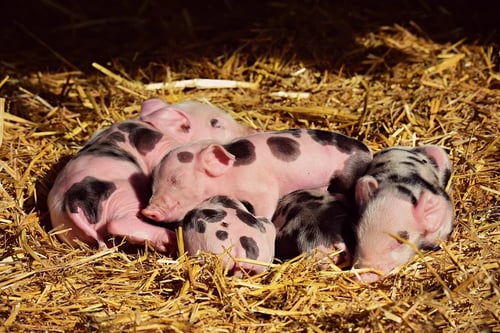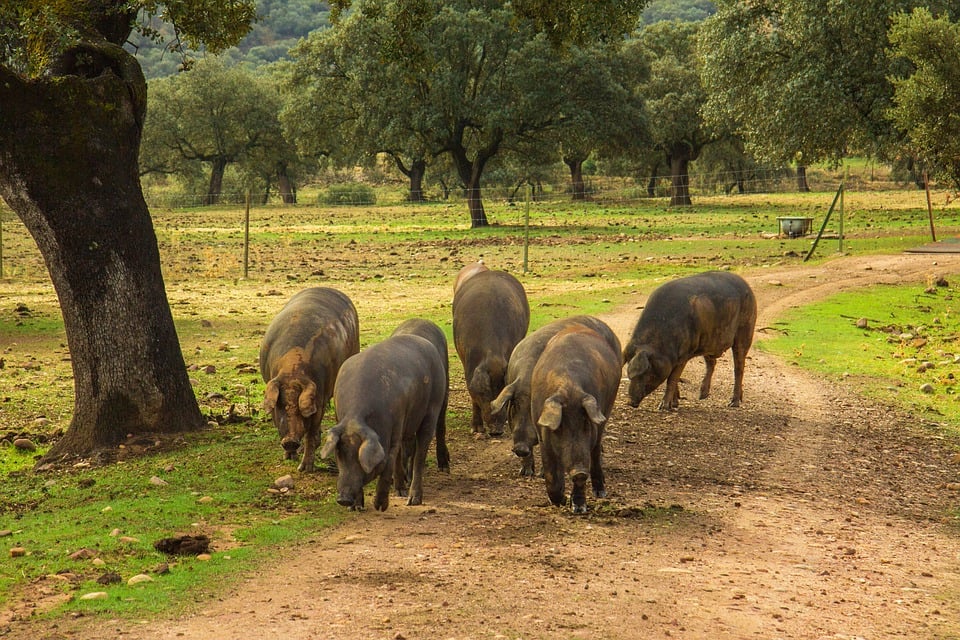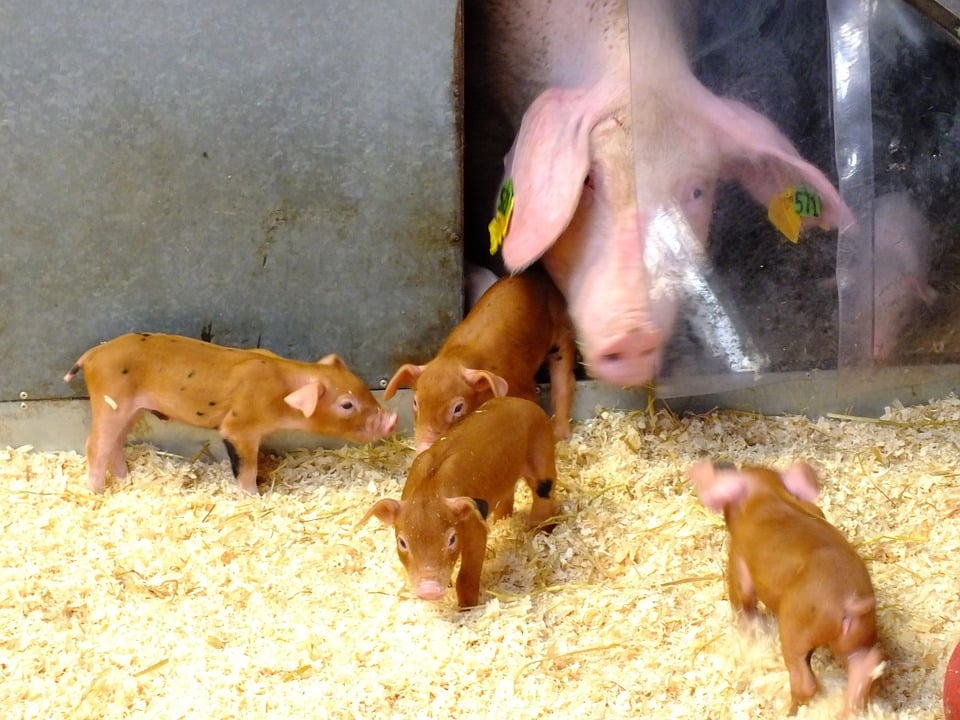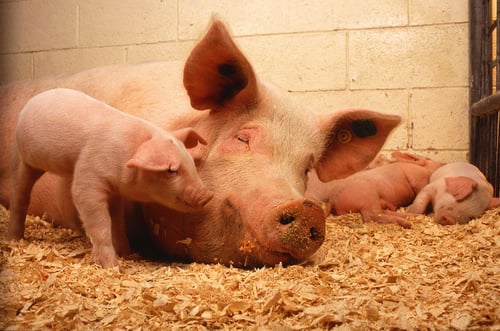11 April 2022
Pros and Cons of Tail Docking Pigs
Piglets are born wet, frail, and defenceless. Managing the farrowing pen correctly leads to more piglets surviving their first, crucial hours .
Tail docking is usually performed on piglets during their first week of life to prevent tail biting. Tail docking is illegal in the European Union (Council Directive 2008/120/EC) —with a few caveats. According to European legislation, it can only be used when there is evidence of bitten tails, and other measures have been unsuccessful in reducing tail biting, but not as a routine measure. However, despite attempts to phase out the practice, tail docking is still widely used by pig farmers far and wide. Except for a handful of countries, such as Finland, that have tried to rear full-tailed pigs as a point-of-pride for the national pig industry, up to 99% of pigs are docked in the EU (Valros & Heinonen, 2015).
The reason that tail docking is still so widespread is that tail biting is a serious behavioural issue that can damage the welfare of pigs as well as the farm’s profitability. Tail biting can lead to severe lesions, infections, abscesses, pig losses from euthanasia as well as carcass condemnation, and penalties imposed by abattoirs. Even pigs with bitten tails that do not develop severe injuries may gain less weight, display altered behaviours, and perform poorly (Sutherland & Tucker, 2011). Many farmers prefer the brief distress of tail docking to the devastating effects of tail biting.
There is no single factor that precipitates this behaviour. Overstocking, general health issues, and an impoverished environment all increase the risk of tail biting; furthermore, once the problem starts, it can spread quickly through a group and it is very difficult to stop (De Briyne et al., 2018). A very strong argument against it is that tail docking does not address the root cause of tail biting. However, once the problem has appeared, there might be no recourse other than to dock pigs’ tails.
There are two main methods used to dock piglets’ tails: blunt trauma (cutting it with scissors, tooth clippers, or a scalpel), and cauterising the tail with a hot iron. Both methods seem to cause pain and discomfort, however, Sutherland et al. (2008) found that using a cauterising iron causes a much lower release of cortisol —the stress hormone. How much tail should you dock? Advice and guidelines change from country to country, but the consensus is that you should spare at least 2cm of the tail (Sutherland & Tucker, 2011).
How can you reduce tail biting other than by docking? Providing sufficient space, enough access to feed and water, and enriching the environment all seem to have a positive effect on tail biting. Rooting materials such as peat and dirt, but especially straw, seem to be effective in reducing the problem. Providing straw can reduce tail biting by up to 50% (Sutherland & Tucker, 2011).
There is no doubt that the pros and cons of tail docking pigs are not clear-cut, and that every farm will have to decide with the help of their veterinarian. However, we should be aware that tail docking is only a surface-level solution that does not address the real issue.
Table 1. The pros and cons of tail docking
|
Pros |
Cons |
|
It reduces tail biting. |
It does not address the root cause of tail biting. |
|
It is a cost-effective, easy procedure. |
It causes pain and distress to piglets. |
|
The harm of tail docking is much lesser than the harm of tail biting. |
The long-term effects of tail docking are not fully understood. |
|
It prevents infections, carcass condemnation, and losses. |
Improperly docked piglets can get infected too. |
|
It is used by pig farmers all over the world. |
It is illegal under EU regulation (except under certain circumstances). |

Piglets love straw. When given something to sniff, bite, scratch, and dig, piglets seem content to leave each other’s tails alone. However, straw might not be compatible with waste disposal systems in all farms .
Pig Teeth Clipping Procedure
To clip piglets’ teeth, you will need a clipper, some disinfectant, and a marker (to keep track of the piglets you have clipped). Remember that pigs’ teeth should be clipped in piglets younger than 7 days but not older. The pig teeth clipping procedure is straightforward:
- Hold the piglet firmly cradled between your arm and your body.
- Open its mouth with the index finger of your holding hand and take its head with your other fingers.
- Start with the upper teeth. While keeping the clipper perpendicular to the gums, clip the tip of the incisor and the canine. You should leave two-thirds of the tooth’s length intact.
- Proceed with the lower teeth on the same side.
- Follow suit with the upper teeth on the other side.
- Proceed to clip the last, lower (mandibular) teeth.
- Run the tip of your finger to verify that you did not leave any pointy or rough edges.
The trick is to avoid clipping too much tooth, wounding the tongue, lips, or gums. You should also prevent the tooth from chipping or fracturing by using the sharpest clippers at your disposal, so that they cut the tooth instead of crushing it. You want to clip the tip of the tooth and avoid reaching the root canal, which leads to bleeding, more pain, and even infection.
Some prefer to ground the teeth using a grindstone, instead of clipping. The procedure is the same and the same principles apply. However, some researchers have found that grinding is inferior to clipping and can lead to lower performance and mortality (Gallois et al. 2005).
The rationale behind clipping piglets’ teeth is that their sharp, corner teeth can damage the sow’s tits as well as wound other piglets in their litter when they play or fight. However, Gallois et al. (2005) did not find any significant differences in tit wounds or performance between groups with clipped and intact teeth, even though they found more skin lesions in piglets, but the majority of these were not severe. On the contrary, these researchers found that dental injury had negative health and welfare consequences. They also found that there is a lot of variation in the amount of gum and teeth injuries, depending on who did the clipping. Therefore, proper technique is crucial!
On the other hand, Australian researchers that looked at an even larger sample of litters found that teeth clipping had a very positive effect, with clipped piglets gaining an extra 200g at weaning and their litters having a 4.6% reduced mortality (Holyoake et al., 2004). How can this be explained? One of the biggest causes of mortality after farrowing is that the weakest piglets are not able to suckle. Thus, by clipping their corner teeth, the more dominant piglets take a step back and give their meeker litter mates a fighting chance. In selective clipping (when you only clip the corner teeth of the biggest piglets) mortality is even lower. Fewer skin wounds from bites mean more piglets making it through the difficult farrowing and pre-weaning periods.
However, keep in mind that the European legislation (Council Directive 2008/120/EC) prohibits teeth clipping in pigs solely for preventive purposes. There has to be evidence of tit wounds, biting, or facial scarring in piglets. Very much like tail docking, teeth clipping tries to fix the symptoms, not the root cause of a deeper problem. In a properly managed farrowing unit–where piglets are given enough space, bedding, warmth, and opportunities to suckle–pigs are unlikely to display behavioural issues in the first place.
Table 2. Pros and cons of pig teeth clipping
|
Pros |
Cons |
|
Reduces damage to sows’ tits. |
No actual proof that this is the case, there is contradictory evidence at best. |
|
Reduces skin injuries caused by littermates. |
Creates an injury of its own: gum, lip, tongue, and tooth damage are common. |
|
Reduces mortality and increases weaning weight. |
Proper farrowing unit management can accomplish the same. |
|
When done properly, it has no long-term negative effects. |
Only experienced, competent personnel can perform the procedure correctly. |
|
It is practised by pig farmers all over the world. |
Pig teeth clipping as a routine measure is illegal under European Union (EU) legislation. |
Pig Castration and EU Legislation
The Council Directive 2008/120/EC lays down the minimum standards for the protection of pigs and it prohibits pig castration after 7 days without anaesthesia and analgesia. The EU is working towards phasing out the surgical castration of pigs altogether. In 2010, representatives and stakeholders from the European pig industry met and produced a Declaration on alternatives to surgical castration of pigs with two objectives: to only castrate pigs using analgesia and/or anaesthesia by 2012, and to completely abandon surgical castration by 2018. These ambitious goals have not been achieved. At present, very few countries castrate the majority of their piglets using both analgesia and anaesthesia. In their last available report from 2018, the expert group on ending the surgical castration of pigs, between 2015 and 2017, France and Germany increased their entire pig production by 22% and 20%, respectively (Backus et al., 2018). However, we must recognise that castration is still widespread. For example, in the same report we learn that most European countries castrate more than 90% of their male pigs. Only Iceland, Norway, Finland, and Switzerland use both analgesia and anaesthesia to castrate most of their piglets.
The picture is further complicated because European countries have very different traditions and production systems. Several countries already have a long history of turning out entire males, for example, Spain (80%), the UK (98%), and Ireland (100%) (De Briyne et al., 2016; Backus et al., 2018). The Netherlands has been increasing its rearing of non-castrated pigs. In these countries, abandoning surgical castration will not pose a significant challenge to farmers. In other countries, it will not be a simple matter. For this reason, countries such as France and Switzerland have opted for the banning of surgical castration without general anaesthesia but not castration altogether.
The main reason to castrate male pigs is to avoid boar taint, a strong, unpleasant smell that is present in the meat of some entire males (De Briyne et al., 2016). Because boar taint has an important market effect, it is the main obstacle in phasing out castration in Europe. At present, the objectives stated by the Declaration on alternatives to surgical castration of pigs represent a voluntary movement from industry stakeholders but it is not ensconced in law.
There are several methods to castrate male piglets. The tearing of the tissues is now prohibited by the EU. However, the surgical removal of the testes in piglets under 7 days old is still allowed, even if no anaesthesia or analgesia is used. For older pigs, a veterinarian must perform the procedure and use deep anaesthesia as well as provide post-operative painkillers (analgesia). Vaccines for immunocastration have also been developed, but only Belgium has adopted this technique in any significant numbers (De Briyne et al., 2016).
Castration is, without a doubt, a controversial subject that you should take into account while managing a farrowing unit. If you want to delve deeper into castration as well as its welfare, health, and economic implications, this article might interest you.

Some countries, such as Spain, rear non-castrated males and have a proud pig industry. Guijuelo boars yield world-famous Iberian ham .
Best Practises for Administering Iron in Piglets
Piglets are fast-growing animals that soon outgrow many of the nutrient reserves they are born with. This is the case, especially with iron, a mineral necessary to carry oxygen in the blood. Quite simply, without enough iron, piglets will develop anaemia. This has enormous consequences for productive outcomes, as anaemic pigs will underperform, become more susceptible to disease, and never reach their full potential.
Piglets are born with only 50g of iron and they might run out of it by day 3. Sows can only provide from 10% to 20% of piglets’ daily iron requirements because sow milk is naturally low in iron. This is the reason why, as part of your farrowing unit management, you need to provide iron supplementation. Iron supplements come in two presentations: oral and injected. Oral supplementation has two drawbacks: first, it is difficult to give piglets an exact dose, which means that many will underperform; second, the immature gut of piglets cannot readily absorb sufficient iron. On the other hand, injected iron is easy to dose accurately, it is safe for piglets, and they can make use of it. Giving pigs in your farrowing unit a shot of iron in the first 3 days of life is the best practice.
Up to 40% of piglets are born with suboptimal iron levels. Learn what you can do to prevent anaemia in your farrowing unit and treat iron deficiency in pigs .
Treating Coccidiosis in Piglets
Most piglets get coccidiosis in the farrowing pen. Coccidia are microscopic, one-celled parasites that infect the gut of pigs, causing coccidiosis. To become infected, a piglet has to swallow “mature” Coccidia eggs, called sporulated oocysts. The parasite then goes through several stages in the intestine, where it multiplies and damages the gut lining of your piglets, impairing their ability to absorb nutrients and grow. Each infected pig, even if it does not show signs of being ill, can shed thousands of oocysts and become predisposed to other diseases such as clostridiasis (Clostridium perfringens type A). Oocysts are very resistant in the environment and lie in wait for the next litter.
The main symptom of coccidiosis is watery to creamy, white to yellow, foul-smelling diarrhoea. It is very rare for piglets to get sick before day 5, but coccidiosis scour usually starts between days 7 and 10. Many of the pigs in a group can become sick and, even if very few of them die, coccidiosis has a huge impact on their productive future.
Currently, there is no vaccine against Coccidia, so we rely on hygiene, disinfection, coccidiostats, and sound management of the farrowing unit to protect our piglets against this sneaky parasite. Coccidiostats stop Coccidia from multiplying and they are the best therapeutic option we have against these parasites.
Once scour sets in, there is only so much you can do for that piglet other than providing supportive therapy. For this reason, it is very important to carry out a periodic diagnosis against coccidiosis on the farm. If the result is positive, it is important to start treatment for all piglets, even if we do not see clinical signs in the litters (e.g. presence of diarrhoea). As for the other groups or litters in the farm, it is best practice not to wait for scour to appear, but to start them on coccidiostats as soon as possible; this is called prophylaxis. Once the gut lining has been invaded by Coccidia, the damage is done.
If you would like to know more about treating coccidiosis in piglets, this article might interest you.

Most piglets get coccidiosis from the farrowing pen.
All-in-all-out management, thorough cleaning, disinfection, and judicious use of coccidiostats are all key to a successful farrowing unit.
References
Backus, G., Higuera, M., Juul, N., Nalon, E., & De Briyne, N. (2018). Second progress report 2015–2017 on the European declaration on alternatives to surgical castration of pigs. Boars on the Way. https://www.boarsontheway.com/wp-content/uploads/2018/08/Second-progress-report-2015-2017-final-1.pdf
Council Directive 2008/120/EC of 18 December 2008 laying down minimum standards for the protection of pigs. (2008). Official Journal of the European Union, 47(52), 5-13. https://eur-lex.europa.eu/legal-content/EN/TXT/?uri=OJ%3AL%3A2009%3A047%3ATOC
De Briyne, N., Berg, C., Blaha, T., & Temple, D. (2016). Pig castration: will the EU manage to ban pig castration by 2018? Porcine Health Management, 2(1), 1-11. https://doi.org/10.1186/s40813-016-0046-x
De Briyne, N., Berg, C., Blaha, T., Palzer, A., & Temple, D. (2018). Phasing out pig tail docking in the EU-present state, challenges and possibilities. Porcine health management, 4(1), 1-9. https://doi.org/10.1186/s40813-018-0103-8
Gallois, M., Le Cozler, Y., & Prunier, A. (2005). Influence of tooth resection in piglets on welfare and performance. Preventive Veterinary Medicine, 69(1-2), 13-23. https://doi.org/10.1016/j.prevetmed.2004.12.008
Holyoake, P. K., Broek, D. J., & Callinan, A. P. L. (2004). The effects of reducing the length of canine teeth in sucking pigs by clipping or grinding. Australian Veterinary Journal, 82(9), 574-576. https://doi.org/10.1111/j.1751-0813.2004.tb11207.x
Sutherland, M. A., Bryer, P. J., Krebs, N., & McGlone, J. J. (2008). Tail docking in pigs: acute physiological and behavioural responses. Animal, 2(2), 292-297. https://doi.org/10.1017/S1751731107001450
Sutherland, M. A., & Tucker, C. B. (2011). The long and short of it: A review of tail docking in farm animals. Applied Animal Behaviour Science, 135(3), 179-191. https://doi.org/10.1016/j.applanim.2011.10.015
Valros, A., & Heinonen, M. (2015). Save the pig tail. Porcine Health Management, 1(1), 1-7. https://doi.org/10.1186/2055-5660-1-2

